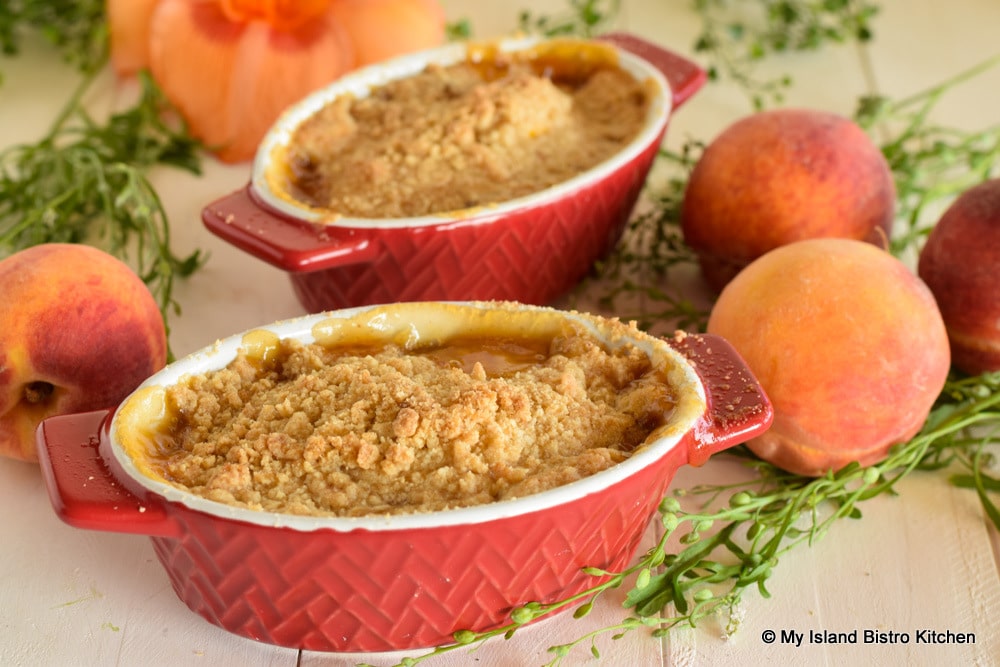
Today, I am making Peach Crumble for dessert. Mid-summer always brings an abundance of lovely seasonal fruits and I adore peaches so it is never a problem coming up with wonderful ways to use them. Continue reading Perfect Peach Crumble Recipe

Today, I am making Peach Crumble for dessert. Mid-summer always brings an abundance of lovely seasonal fruits and I adore peaches so it is never a problem coming up with wonderful ways to use them. Continue reading Perfect Peach Crumble Recipe
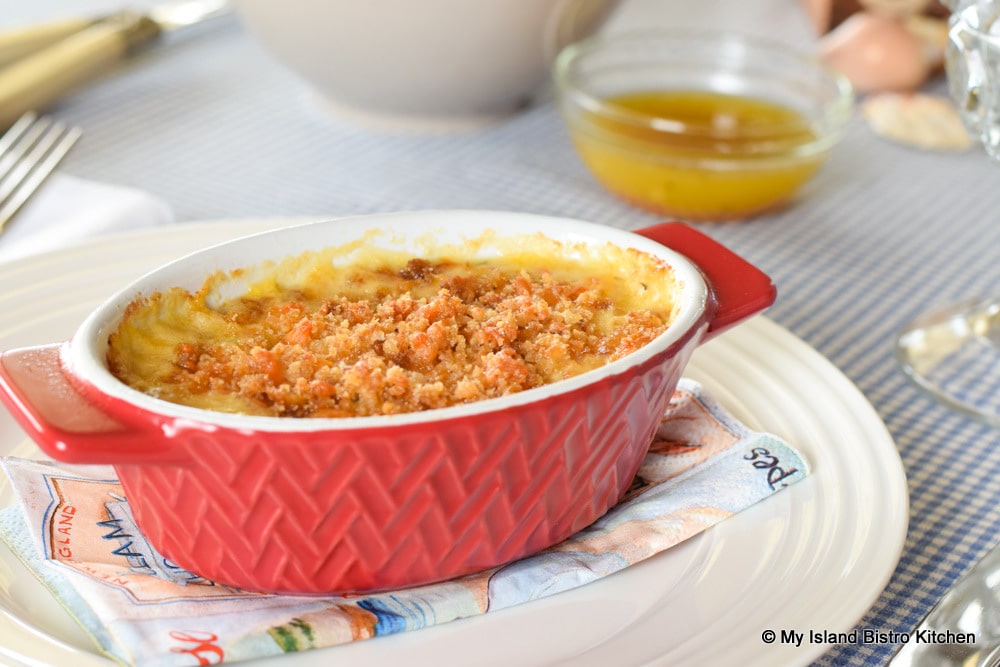
When you live on an Island where fishing is one of the main industries, it means you have access to wonderful fresh seafood. Yes, we are spoiled! Here in Prince Edward Island, where I reside, I make good use of seafood in my diet and in my recipe creations as I have done here with my Seafood Bubbly Bake. Continue reading My Island Bistro Kitchen’s Seafood Bubbly Bake
When you need a bright, colorful, tasty, and refreshing summertime salad, this Watermelon, Cucumber, and Red Onion Salad with Feta, dressed with a light vinaigrette, checks all the boxes. Continue reading Watermelon, Cucumber, and Red Onion Salad with Feta

Two of summer’s best flavors marry to create a wonderful summertime drink. This Rhubarb and Strawberry Cordial checks off all of the boxes one would expect to find in a non-alcoholic summertime drink. It’s super tasty, has fabulous color, is refreshing and thirst-quenching, and can be made ahead and frozen. Continue reading Rhubarb and Strawberry Cordial

Achieving a recipe for gluten-free muffins that closely replicates wheat-based muffins can be a challenge. The good news is, however, that it is indeed possible as demonstrated by these tasty deli-style gluten-free strawberry muffins.
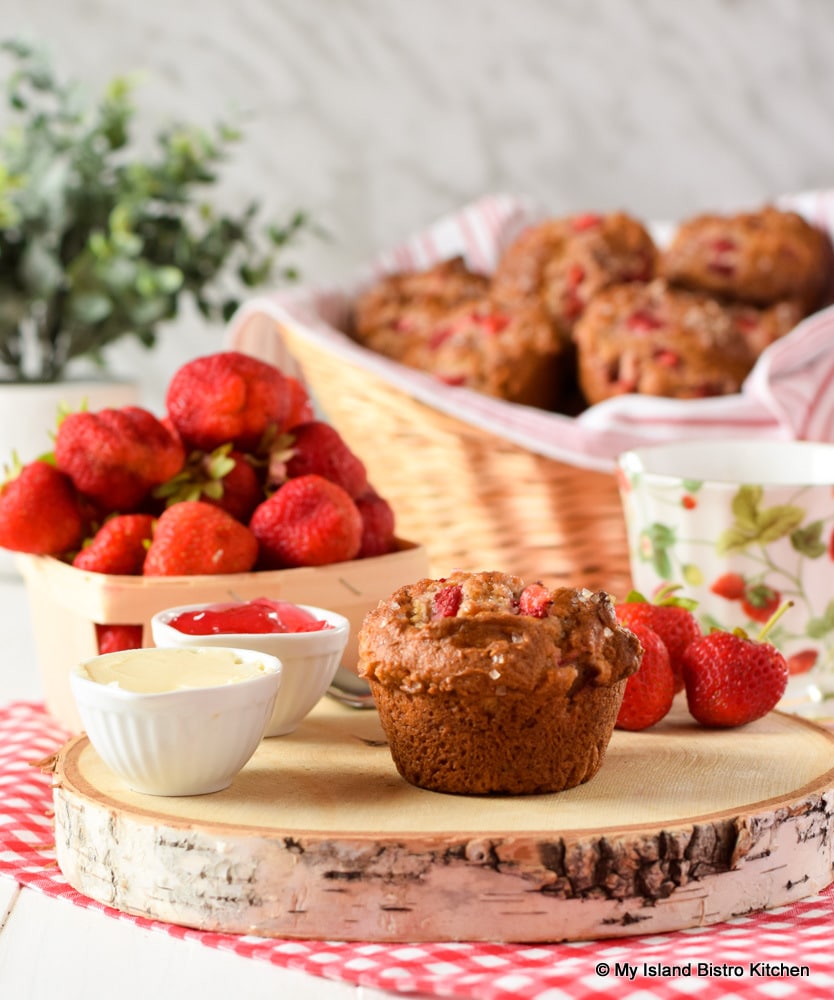
A large part of the challenge surrounds the right blend of gluten-free flours and starches and then finding the right combination and amount of wet ingredients since, as you probably know if you bake gluten-free, each gluten-free flour reacts differently to liquid ingredients. So, while the list of ingredients in my gluten-free muffin recipes may appear long, each ingredient is necessary when a tasty muffin is desired. Of course, I am always aiming to achieve a nicely dome-shaped muffin and one that has a lovely muffin-like texture, much the same as you would expect a muffin to be like when made with wheat flour.

Today, fresh locally grown strawberries are my featured ingredients in muffins. The berries provide a lovely little burst of wonderful flavor in the muffins. I hope you enjoy them as much as I do!
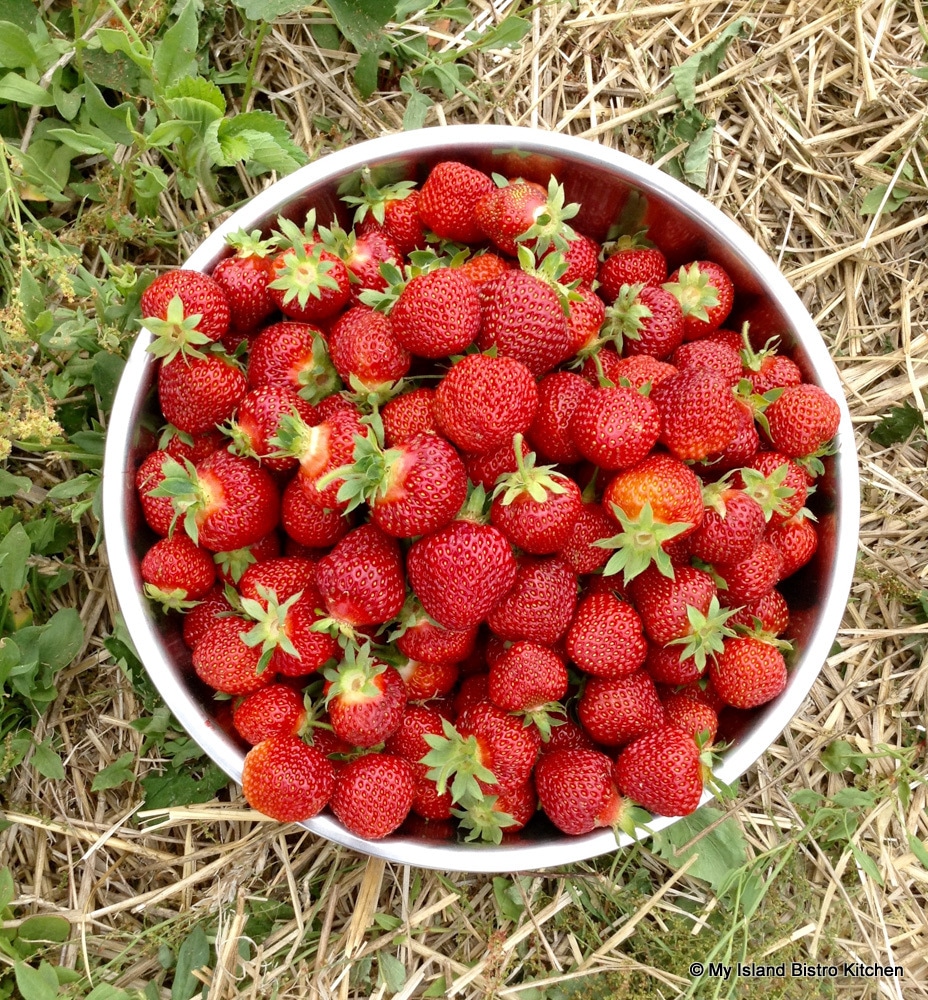
At the bottom of this posting, you will also find links to several other gluten-free muffin recipes I have developed.
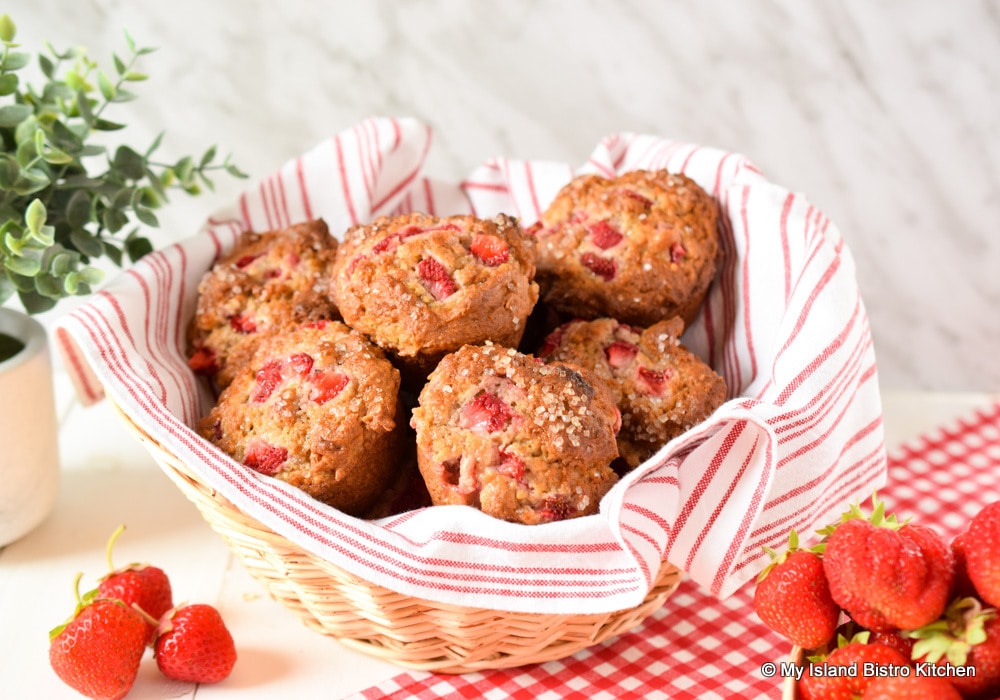
[Printable recipe follows at end of post]
Ingredients:
¾ cup sorghum flour
1/3 cup gluten-free quick cooking rolled oats
¼ cup brown rice flour
¼ cup almond flour
¼ cup gluten-free oat flour
2½ tbsp potato starch
2 tbsp ground chia seeds
1 tbsp + ¾ tsp tapioca starch
1¾ tsp xanthan gum
1 tbsp baking powder
½ tsp baking soda
½ tsp salt
½ tsp cardamom
1/8 tsp ground nutmeg
½ cup light brown sugar, lightly packed
2 large eggs, room temperature, lightly beaten
¼ cup coconut oil
2 tbsp pure maple syrup (no artificial substitutions)
1½ tsp pure vanilla
½ cup Greek-style vanilla yogurt (or ¼ cup plain vanilla yogurt + ¼ cup sour cream)
2 tbsp whole milk mixed with ¼ tsp lemon juice (let sit 5 minutes before using)
1½ cups fresh strawberries, diced (apx. 8 oz)
3 – 4 tsp turbinado sugar (optional)
Method:
Set out the eggs, yogurt, and whole milk to bring them to room temperature. If using solid coconut oil, melt and cool it completely before proceeding with recipe.
Preheat oven to 475°F.
Prepare 12 muffin cups (each at least ½-cup capacity) by spraying each muffin cup with cooking spray or greasing individually.
Whisk the flours, rolled oats, starches, ground chia seeds, xanthan gum, baking powder, baking soda, salt, and spices together in a large bowl. Make a well in the center of the dry ingredients. Set aside.
In separate medium-sized bowl, or large measuring cup, whisk together the brown sugar, eggs, coconut oil, maple syrup, and vanilla. Stir in the yogurt and milk.
Pour wet ingredients into well in dry ingredients. With large spoon, mix ingredients together just until dry ingredients are fully incorporated. Do not overmix. Gently fold in 1 cup of the diced strawberries. Batter will appear very thick, stiff, and somewhat dry at this point. This is normal for this recipe.
Spoon batter into prepared muffin cups, filling each cup to the rim. Sprinkle remaining ½ cup of diced strawberries over the muffins and sprinkle each muffin with a few grains of turbinado sugar, if desired. Transfer muffins to pre-heated oven and immediately reduce oven temperature to 400°F. Bake for apx. 20 minutes, or until muffins are just firm to the touch and a cake tester inserted into center of a muffin comes out clean. Do not overbake or muffins will be dry. Remove from oven and let muffins rest in pan for 5 minutes then gently remove from pan and transfer to wire rack to cool completely.
Yield: 12 standard-sized muffins
Join the Facebook page for My Island Bistro Kitchen: https://www.facebook.com/MyIslandBistroKitchen/
Follow “the Bistro” on Twitter: https://twitter.com/PEIBistro/
See the drool-worthy gallery of mouth-watering food photos from My Island Bistro Kitchen on Instagram: https://www.instagram.com/peibistro/
Follow “the Bistro” on Pinterest at https://www.pinterest.ca/peibistro/ and pin the Pinterest-ready photo at the end of this posting to your favorite Pinterest boards!
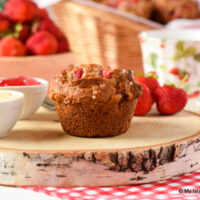
Whisk the flours, rolled oats, starches, ground chia seeds, xanthan gum, baking powder, baking soda, salt, and spices together in a large bowl. Make a well in the center of the dry ingredients. Set aside.
Yield: 12 standard-sized muffins
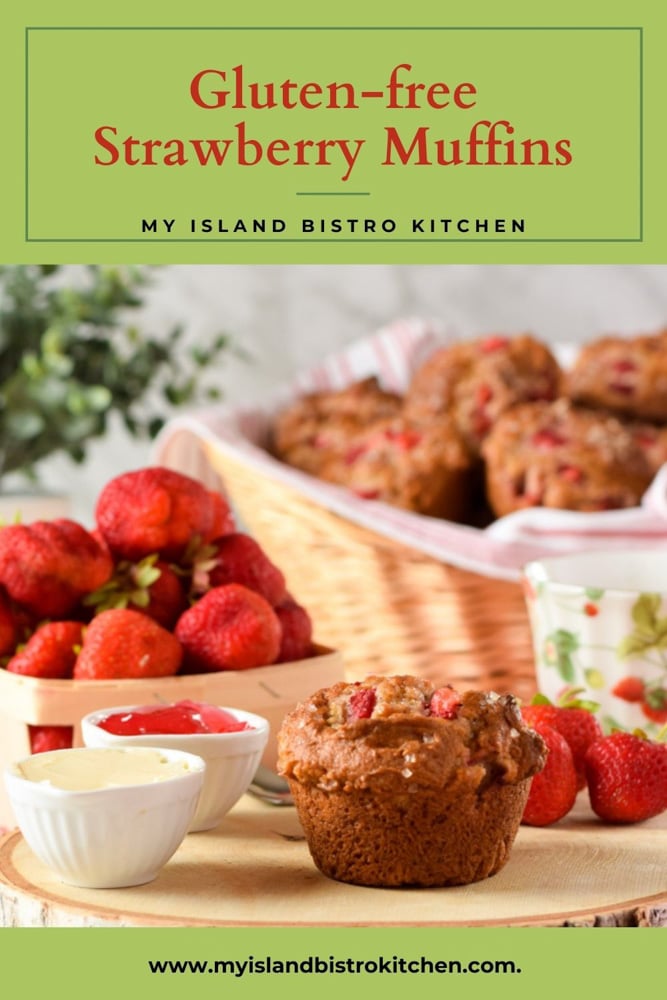
Gluten-free Carrot Zucchini Muffins
Gluten-free Banana Date Muffins
Gluten-free Rhubarb Granola Muffins
Ultimate Gluten-free Zucchini Date Muffins
Gluten-free Pumpkin Mincemeat Muffins
Deli-style Gluten-free Beet Muffins
Gluten-free Blueberry Muffins
Gluten-free Blueberry Zucchini Muffins

These Deli-style Strawberry Muffins are a must make when local strawberries are in season. Those lovely plump, juicy berries add wonderful flavor to a muffin batter that is lightly spiced with cardamom and nutmeg and has just a whisper of citrus notes.
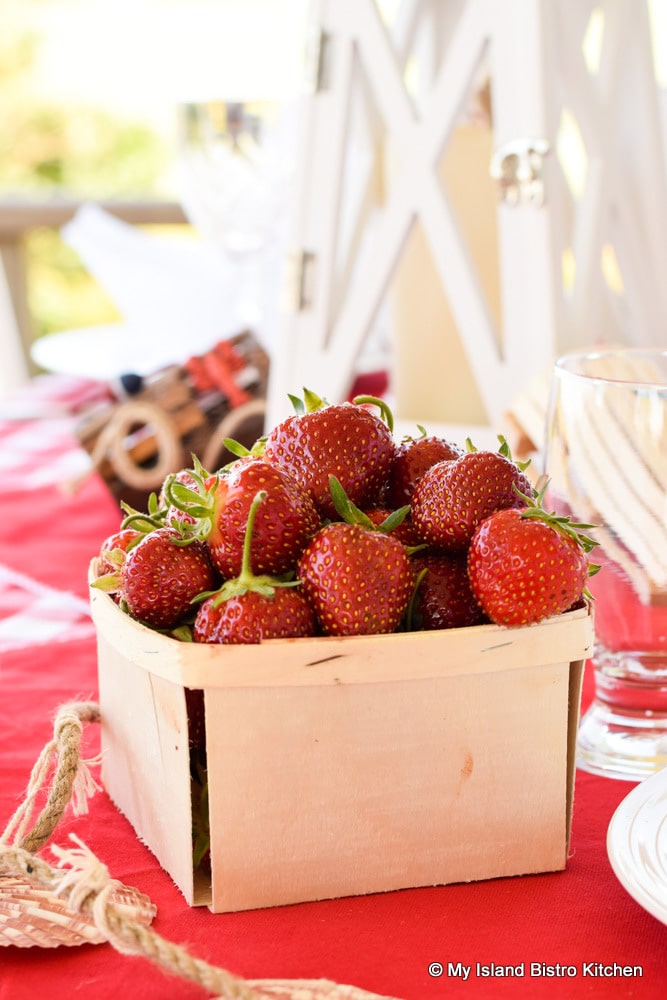
The muffins are perfect for brunch, coffeebreak, or the lunch bag. Dress them up by sprinkling a few grains of turbinado sugar on each muffin just before they go in the oven. It will add a bit of crunch to the muffin top.
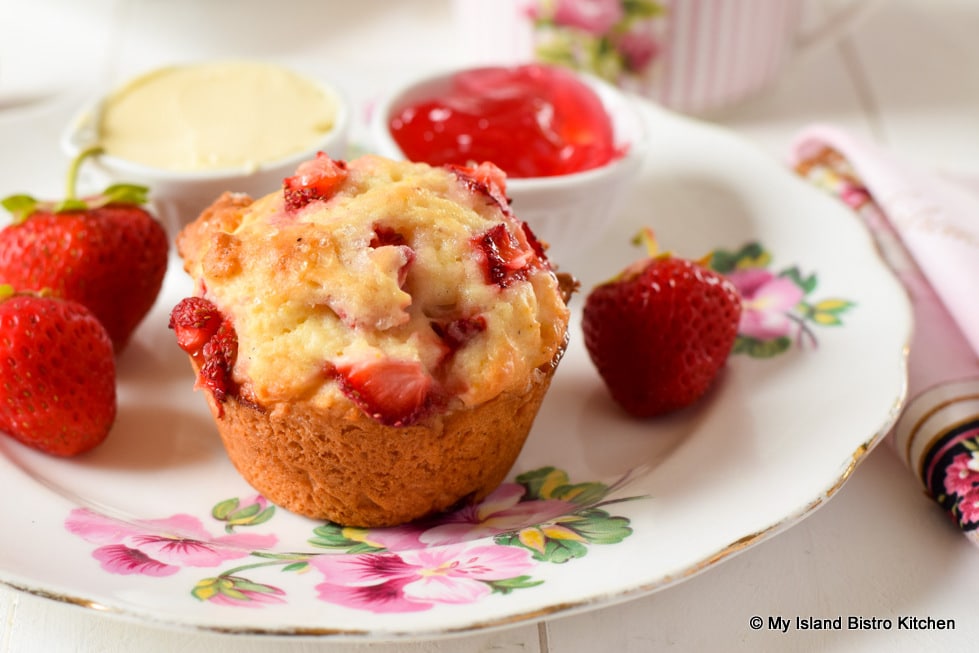
[printable recipe follows at end of post]
Ingredients:
2 cups all-purpose flour
1 tbsp baking powder
½ tsp salt
½ tsp cardamom
⅛ tsp nutmeg
2 tsp finely grated orange rind
2 large eggs, room temperature, slightly beaten
½ cup granulated sugar
½ cup Greek-style vanilla yogurt (or ¼ cup plain vanilla yogurt + ¼ cup sour cream), room temperature
¼ cup vegetable oil
1 tsp vanilla
1½ tbsp milk
1½ cups fresh strawberries, diced (apx. 8 oz)
3 – 4 tsp turbinado sugar (optional)
Method:
Preheat oven to 475°F. Prepare muffin tins by greasing or spraying with cooking oil, ensuring the top edges of each muffin cup are also well-greased/sprayed.
In large bowl, whisk together the flour, baking powder, salt, cardamom, and nutmeg. Stir in grated orange rind. Set aside.
In medium-sized bowl, whisk together the eggs, sugar, yogurt, vegetable oil, vanilla, and milk.
Pour the wet ingredients into the dry and stir only until barely incorporated. Do not overmix. Gently fold in strawberries. Spoon batter into prepared muffin tins, filling each cup three-quarters full. Sprinkle a few grains of turbinado sugar on top of each muffin, if desired.
Transfer muffins to oven and immediately reduce the oven temperature to 375°F. Bake for 23-25 minutes or until muffins are just firm to the touch and a cake tester inserted into the center of a muffin comes out clean.
Let muffins rest in muffin tins for about 5 minutes then transfer to wire rack to finish cooling.
Yield: 12 standard-sized muffins
Join the Facebook page for My Island Bistro Kitchen: https://www.facebook.com/MyIslandBistroKitchen/
Follow “the Bistro” on Twitter: https://twitter.com/PEIBistro/
See the drool-worthy gallery of mouth-watering food photos from My Island Bistro Kitchen on Instagram: https://www.instagram.com/peibistro/
Follow “the Bistro” on Pinterest at https://www.pinterest.ca/peibistro/ and pin the Pinterest-ready photo at the end of this posting to your favorite Pinterest boards!
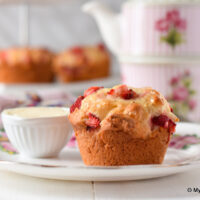
Yield: 12 standard-sized muffins
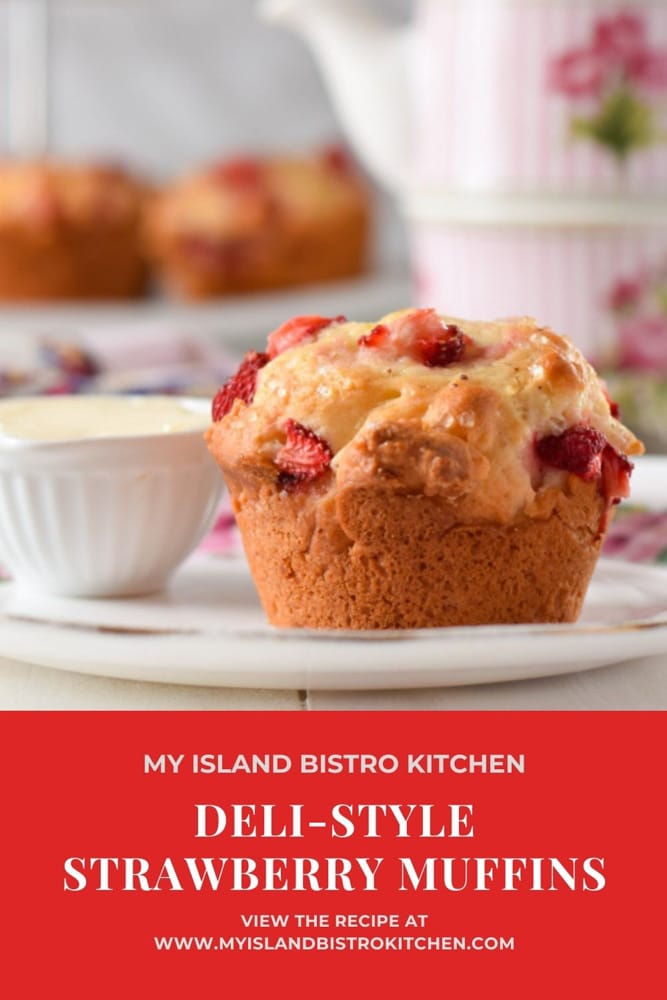

For those of you who are regular followers of my food blog, you know my love of rhubarb! I am always creating new recipes for it and that includes this fabulous beautiful-colored Rosy Rhubarb Jelly made from the strained juice of cooked rhubarb. With the smaller household in mind, I have created this stunning Rhubarb Jelly recipe to be a small batch – it should yield 3 half-pint and 1 quarter-pint jars.

A properly made jelly will be transparent, free from impurities like bits of fruits or their seeds. That’s why it is very important to place the cooked rhubarb pulp in a dampened fine mesh jelly bag through which the juice drips and is strained. The jelly should have a shimmer to it and a bit of jiggle but still be firm enough to hold its shape yet spreadable. While this Rhubarb Jelly is good on toast, it really shines on scones! You can find my regular scone recipe here and my gluten-free version here.

How great does this bright clear jelly look on a scone! It’s look is only matched by the fabulous flavor!

Jelly making is very process oriented and sequential in nature. For this reason, I recommend taking several reads of the method for making this Rhubarb Jelly before beginning. It is not particularly difficult but it does take time and attention. Good organization helps so I suggest setting out all the supplies and equipment needed before beginning.
Getting the exact amount of rhubarb to generate precisely 1½ cups of strained juice can be tricky. This is because the amount of juice extracted will depend on the age and quality of the rhubarb as well as the growing conditions in which it was grown – for example, if it is a wet or dry climate or season. While up to 1/3 cup of water can be added to the strained juice to bring it to the required 1½ cups, it may be a good idea to cook a wee bit extra rhubarb if you are unsure if the rhubarb you are using is of the quality that you can be assured it will juice out 1½ cups. However, if your rhubarb produces more than 1½ cups strained juice, only use the 1½ cups called for in the recipe as adding more liquid will affect the gelling process. I try to add as little water as possible to the rhubarb as it will dilute or weaken the true rhubarb flavor.
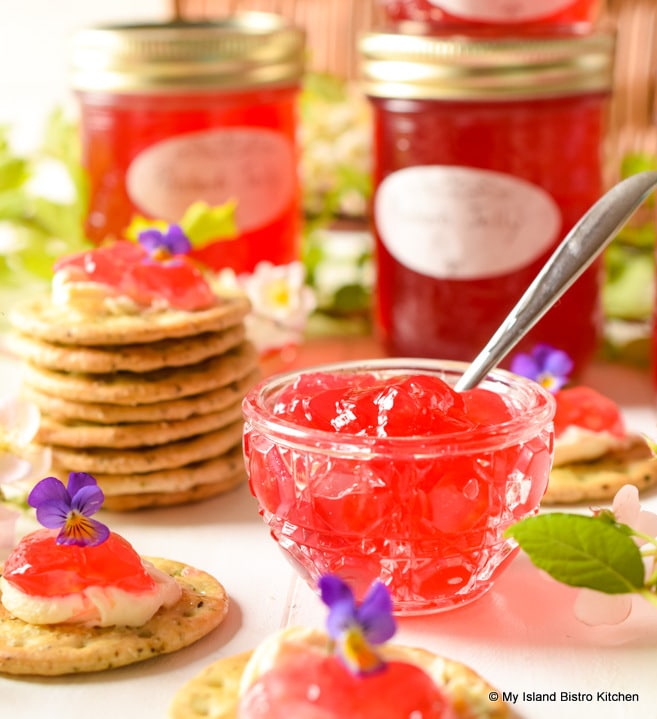
Try this jelly on top of your favorite spreadable cheese on crackers.

And a wee bit of a closer look!

[Printable recipe follows at end of post]
Ingredients:
1¾ lb deep red rhubarb stalks, chopped into ½“ chunks (1¾ lbs weighed after leaves and root ends removed)
2/3 cup water
¼ cup orange juice
3¼ cups granulated sugar
1 tsp butter
1 – 85ml pkg liquid pectin
Supplies and Equipment Needed:
3 half-pint and 1 quarter-pint glass canning jars for the jelly (plus 3 – 4 more half-pint jars to take up extra space in the canner basket during the hot water process (exact number needed will depend on size of canner))
4 – two-piece lid and screw band sets (lids must be brand new and not previously used); screw bands to be checked to ensure no rust or dents
Medium-sized pot for cooking rhubarb
Fine mesh jelly bag for straining cooked rhubarb
Small, heavy-bottomed stock pot for cooking jelly
Large-sized pot for sterilizing jars
Small saucepan for heating jar lids
Water bath canner with basket
Fine mesh jelly bag to filter the rhubarb pulp and strain the rhubarb juice of impurities
Jar lifter tongs
Wide-mouthed canning funnel
Ladle or heat-proof glass measuring cup
Chopstick or small non-metallic heat-proof spatula
Magnetic lid lifter
A timer
Method:
Place rhubarb, water, and orange juice in medium-sized stockpot. Cover and bring to a boil over medium-high heat. Reduce heat to low and simmer for 8-10 minutes, or until rhubarb is very soft and mushy, stirring occasionally. Remove from heat and, using a potato masher, further break down the cooked rhubarb.
Transfer the cooked rhubarb to a dampened fine mesh jelly bag. If you have a jelly bag stand, affix the jelly bag to it suspended over a bowl or pot. However, if you don’t have the formal stand, simply hang jelly bag over a broom handle suspended between two chairs with jelly bag positioned over a bowl or large measuring cup to catch the juice as it extracts.
Let jelly bag containing the rhubarb suspend, undisturbed, to allow the juice to extract and strain on its own. This may take anywhere from an hour or so to a couple of hours or longer, depending on the quality and age of the rhubarb as well as the local climate growing conditions in which the rhubarb was grown. Do not squeeze the jelly bag or try to force the juice through quicker as this will result in a cloudy/murky jelly. The rhubarb pulp should yield 1½ cups of strained juice. However, if it is short the 1½ cups, up to 1/3 cup water may be added to yield 1½ cups liquid. If it yields more than 1½ cups of juice, only use the 1½ cups called for in the recipe as adding more juice will affect the gelling process.
When the rhubarb is nearing the end of its straining, prepare the bottles and canner. Wash jars and lids in hot soapy water, first checking to ensure that the jars have no cracks or chips in them. Rinse. Fill a large pot with hot tap water, about ¾ full. Place the half-pint and quarter pint jars, upright, into the water (the extra bottles will be go into the canner to fill it up so the filled jars do not topple over during the hot water process). While the extra jars do not need to be sterilized, they do need to be hot going into the canner of boiling water as, otherwise, they may crack with the temperature change. Ensure the jars are fully submerged, each jar filled with water, and that the water is at least an inch over the tops of the jars. Cover, bring to a boil, and boil for 10 minutes. Turn off heat and leave the jars in the hot water to have ready to fill once the jelly finishes cooking.
Fill the canner about half full of hot tap water. Cover and bring to a boil to have it ready for processing of the filled jars as the filled jelly jars must immediately go into the canner to be processed while the jelly is still hot. Ensure the canner water is boiling before beginning to cook the jelly as there will not be enough time to get it to the boiling point once the jelly is in the bottles and ready for immediate processing. Boil a kettle of extra water to have ready, if needed, to top up the canner water after filled jars are added.
Place 1½ cups rhubarb juice and the sugar in a small stockpot over medium-high heat. Add the butter. Bring to a full rolling boil, stirring frequently. Add the liquid pectin and boil hard for 1 minute, stirring continuously. Immediately remove stockpot from heat and skim off any residual foam.
Use jar lifter tongs to carefully remove three half pints and the quarter pint hot sterilized jars from the water, one at a time, emptying the water from the jars back into the pot. Drain jars well.
Remove a small amount of the hot water from the stockpot in which the jars were sterilized and place in small saucepan over simmering heat. Place the lids in the hot water to soften the rubber sealing compound. Do not boil the lids.
Using a ladle, or a heat-proof glass measuring cup, and a wide-mouthed canning funnel, pour jelly into the hot sterilized jars, leaving about ¼” headroom in each jar to allow for expansion during the hot water processing. Remove any trapped air bubbles in the jars with a chopstick or small heatproof, non-metallic spatula. Wipe the jar rims with a clean damp cloth to remove any stickiness or jelly particles that could prevent the lids from sealing properly to the jars.
Using a magnetic lid lifter, remove lids from the hot water and center the heated lids on jars so the sealing compound on the lid edges aligns with the jar rims. Fingertip tighten the ring/screw bands until resistance is encountered. Do not over-tighten.
Using jar lifter tongs, carefully place filled jars upright in wire basket positioned in the canner, ensuring jars do not touch each other or fall over. Add some of the hot empty jars, upright, to the basket to fill up space so the filled jars do not topple over. Let the empty jars fill with water from the canner as they are submerged. Ensure the water level is at least 1” above the tops of jars, adding more boiling water as necessary. Cover with canner lid. Return the water to a full rolling boil over high heat then decrease the heat to just keep the water at a moderately rolling boil but not boiling over. Process jars in the hot water bath for 10 minutes, adjusting time as and if necessary for altitude. Start timing the processing from the point at which a full rolling boil is reached after jars have been added to the canner. At the end of the processing time, turn off heat and remove canner lid.
Let jars sit in the hot water for 5 minutes then, using jar lifter tongs, carefully remove the jars filled with jelly, upright and one at a time, and transfer them to a heat-proof cutting board that has been covered with a towel, to cool completely. Listen for the “pop” or “ping” sound as the bottles seal over the next few minutes or hours. The lids of properly sealed jars will curve downward. Let jars rest, undisturbed, on counter for 24 hours. Then, test each jar for proper sealing by pressing down gently on the center of each jar lid. If the lid is already pressed downward, and does not pop back up, it is properly sealed. Any jars that do not pass this test should be refrigerated and the jelly used within a week or so. Store properly sealed jelly bottles in cool, dark place. Refrigerate jelly once jar has been opened.
Yield: Apx. 3 half-pint bottles and 1 quarter-pint bottle
NOTE 1: The small ½-cup (quarter-pint) jar does not actually need the full 10 minutes of hot water canning. However, to remove it partway through, at the 5-minute point in the boiling process, would disturb the rolling boil and timing and thus interfere with the proper canning of the larger half-pint jars so, there are a couple of options. The first is to let the small jar remain in the hot water bath with the half-pint jars for the full 10-minute period. The second option is not to process the tiny jar in the hot water and to, instead, use it as the “tasting jar”, refrigerating and consuming the jelly within a couple of days. However, if the desire is to can the entire batch of jelly into the small ½-cup (quarter-pint) jars, then process the basket of them for 5 minutes, instead of 10. These tiny bottles make great gifts, especially if they are accompanied by fresh scones!
Join the Facebook page for My Island Bistro Kitchen: https://www.facebook.com/MyIslandBistroKitchen/
Follow “the Bistro” on Twitter: https://twitter.com/PEIBistro/
See the drool-worthy gallery of mouth-watering food photos from My Island Bistro Kitchen on Instagram: https://www.instagram.com/peibistro/
Follow “the Bistro” on Pinterest at https://www.pinterest.ca/peibistro/ and pin the Pinterest-ready photo at the end of this posting to your favorite Pinterest boards!
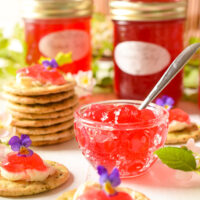
Yield: Apx. 3 half-pint bottles and 1 quarter-pint bottle
NOTE 1: The small ½-cup (quarter-pint) jar does not actually need the full 10 minutes of hot water canning. However, to remove it partway through, at the 5-minute point in the boiling process, would disturb the rolling boil and timing and thus interfere with the proper canning of the larger half-pint jars so, there are a couple of options. The first is to let the small jar remain in the hot water bath with the half-pint jars for the full 10-minute period. The second option is not to process the tiny jar in the hot water and to, instead, use it as the “tasting jar”, refrigerating and consuming the jelly within a couple of days. However, if the desire is to can the entire batch of jelly into the small ½-cup (quarter-pint) jars, then process the basket of them for 5 minutes, instead of 10. These tiny bottles make great gifts, especially if they are accompanied by fresh scones!
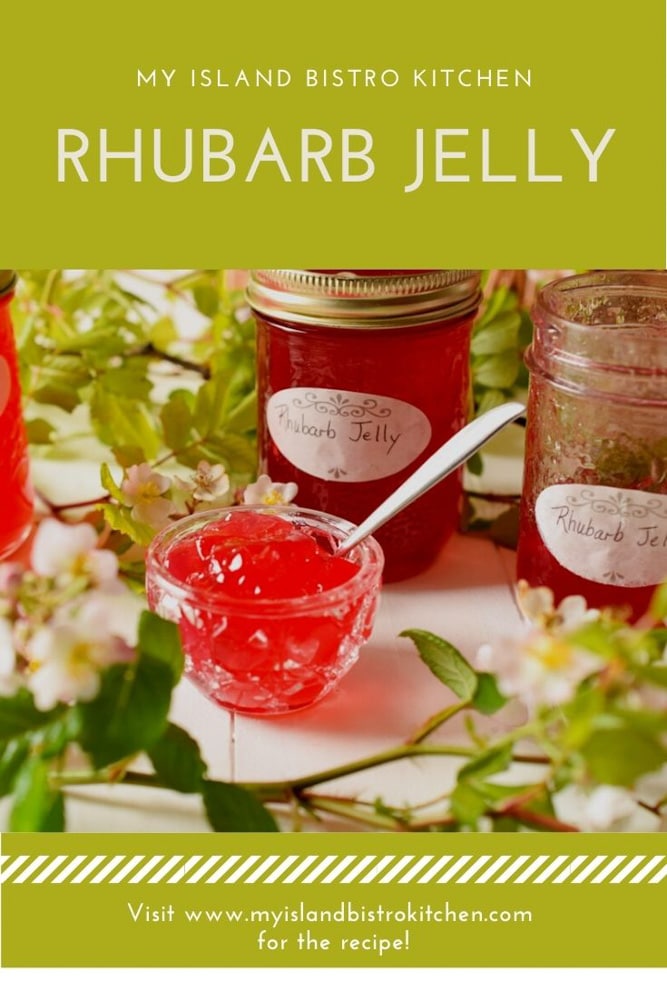
Jams
Strawberry Rhubarb Freezer Jam
Blueberry and Grand Marnier Jam
Gooseberry Jam
Zucchini Jam
Pumpkin Jam
Small Batch Cherry Jam
Jelly
Crabapple Jelly
Marmalade
Green Tomato Marmalade
Rhubarb Marmalade
Peach Marmalade

This classic Broccoli Salad is wonderfully tasty and can be served with a number of different meals. It is great for potlucks, cookouts, and picnics (provided, of course, it is kept cold due to the mayo and sour cream content). Continue reading Classic Broccoli Salad Recipe
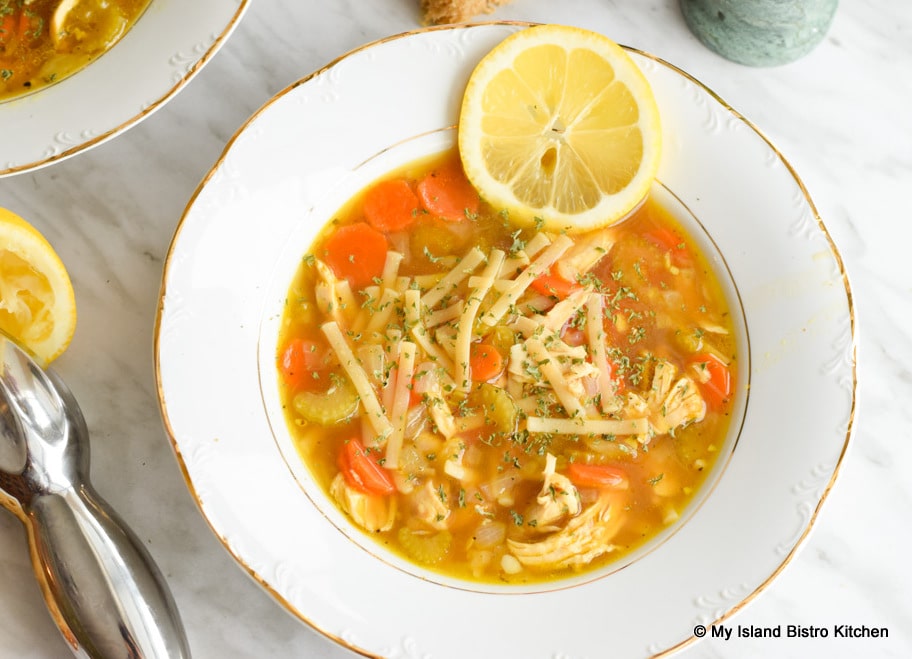
Sometimes, nothing but a soothing old-fashioned soup will do and it doesn’t get more classic than this comforting Homestyle Chicken Noodle Soup. Continue reading Homestyle Chicken Noodle Soup Recipe
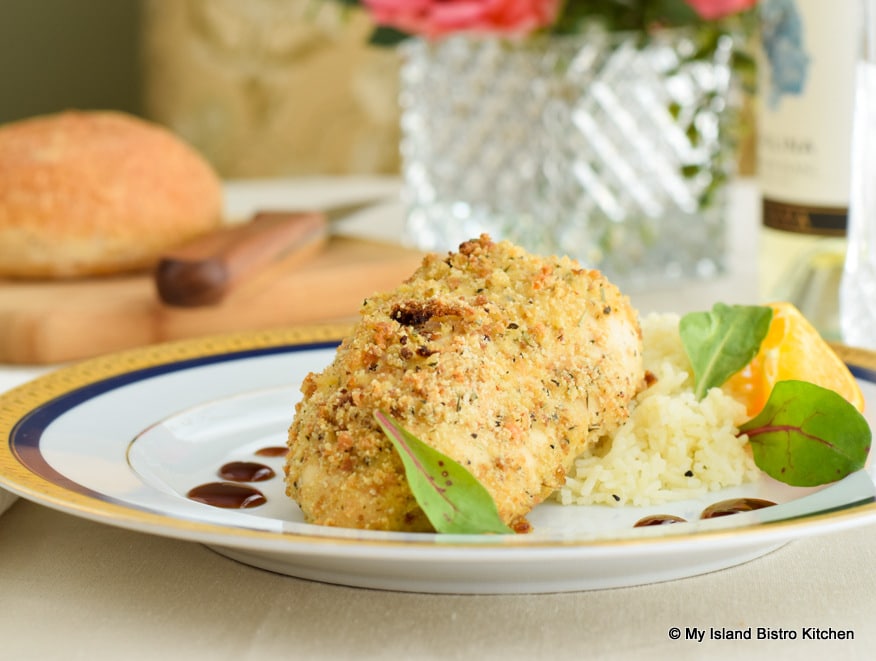
Designed with the smaller household of two in mind, the recipe for these delectable Goat Cheese and Basil Pesto Stuffed Chicken Breasts is easily scalable to the number of servings required. So, for example, if you need four servings, simply double the ingredients called for in the recipe. Continue reading Goat Cheese and Basil Pesto Stuffed Chicken Breasts

These Custard Sandwich Cookies bear some resemblance to those that many know as Melting Moments, my recipe for which can be found here. The primary difference between these Custard Sandwich Cookies and Melting Moments is that the latter contains cornstarch giving the cookies what is commonly known as a “short”, ever-so-slightly crisp, texture while the Custard Sandwich Cookies contain vanilla custard powder that gives them a wonderful soft, creamy, and slightly crumbly texture as well as additional flavor and a more yellowish color. Continue reading Custard Sandwich Cookies Recipe

St. Patrick’s Day is the perfect time to create and serve a delightful St. Patrick’s Day Grazing Board filled with all kinds of green, orange, and white snacking foods! Continue reading St. Patrick’s Day Grazing Board
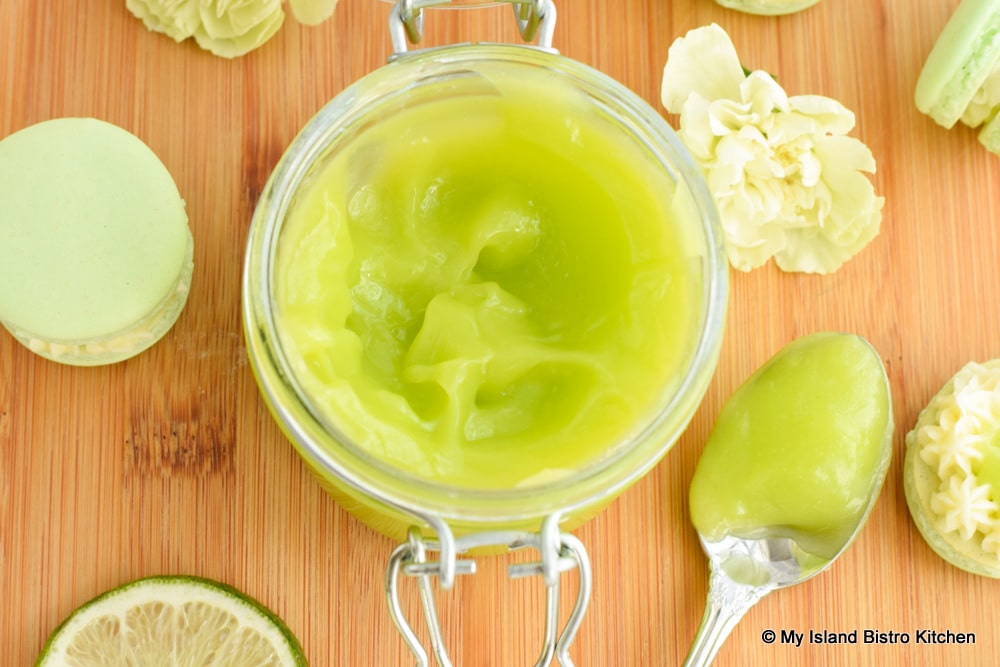
Sharper and with a tangier taste than lemon curd, lime curd (in its natural state) is a slightly duller color than the traditional lemon curd with which most people are probably more familiar. One would think lime curd would automatically have a lime green color but this is not the case as the juice from limes is actually a very pale bland color. I added just a touch of green gel icing coloring to brighten up the curd and give it a pretty lime green color, more consistent to what might be expected of the appearance of a lime curd. Continue reading Luscious Lime Curd Recipe
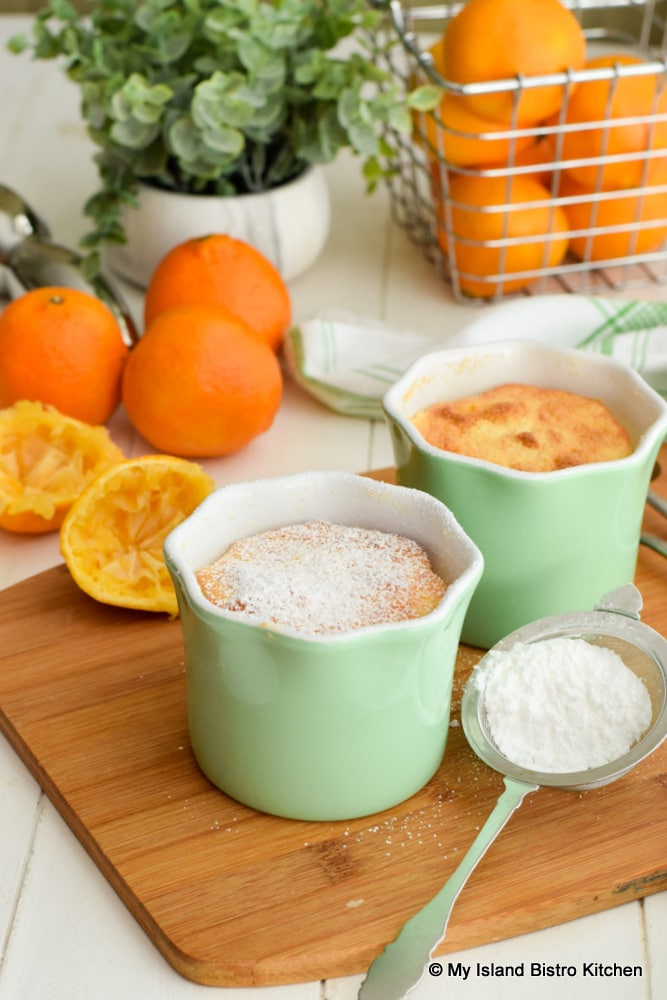
This self-saucing Clementine Sponge Pudding, baked in a bain marie, consists of a lovely citrus-flavored sauce topped with a light-as-air sponge cake. The pudding is proportionately sized for two servings making it ideal for the small household. Continue reading Clementine Sponge Pudding for Two

These powerhouse Roasted Peanut and Mocha Energy Bars are a substantial snack. They are a great pick-up snack anywhere and any time. Continue reading Roasted Peanut and Mocha Energy Bars Recipe

Some may know this old-fashioned bread simply as “Porridge Bread” because of its rolled oat content. Rustic Oatmeal Bread is a hearty bread that has a soft, chewy texture. It’s ideal as a sandwich bread, makes fabulous toast, is great for French toast and, heck, it’s just fine slathered with butter or molasses! Continue reading Rustic Oatmeal Bread Recipe (aka Porridge Bread)
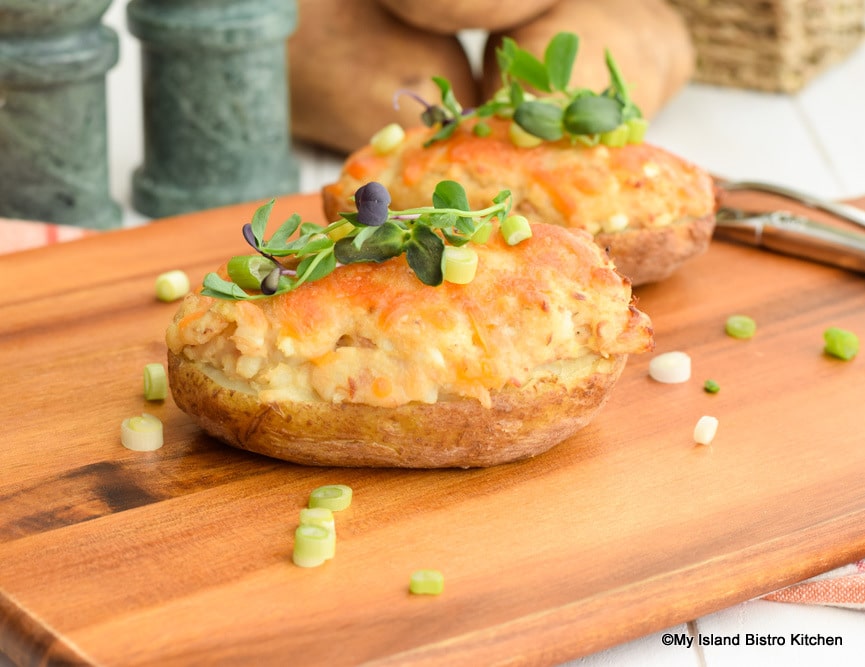
These tasty Tuna Stuffed Potatoes are the full meal deal. With a filling of potato, tuna, egg, and cheese, all encased in potato shells, these twice-baked potatoes make a great lunch all on their own. Continue reading Tuna Stuffed Potatoes Recipe
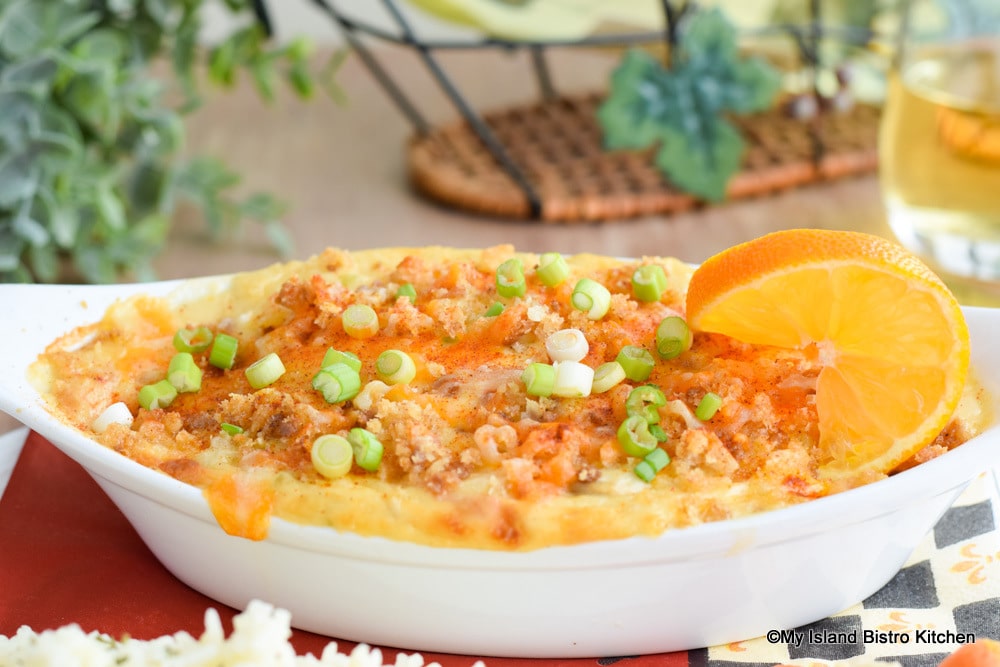
At least once a week, I have fish. Haddock is a favorite and while I like it simply pan-fried in butter, sometimes I like to dress it up and, on those occasions, I make Baked Haddock au Gratin. Continue reading Baked Haddock au Gratin Recipe
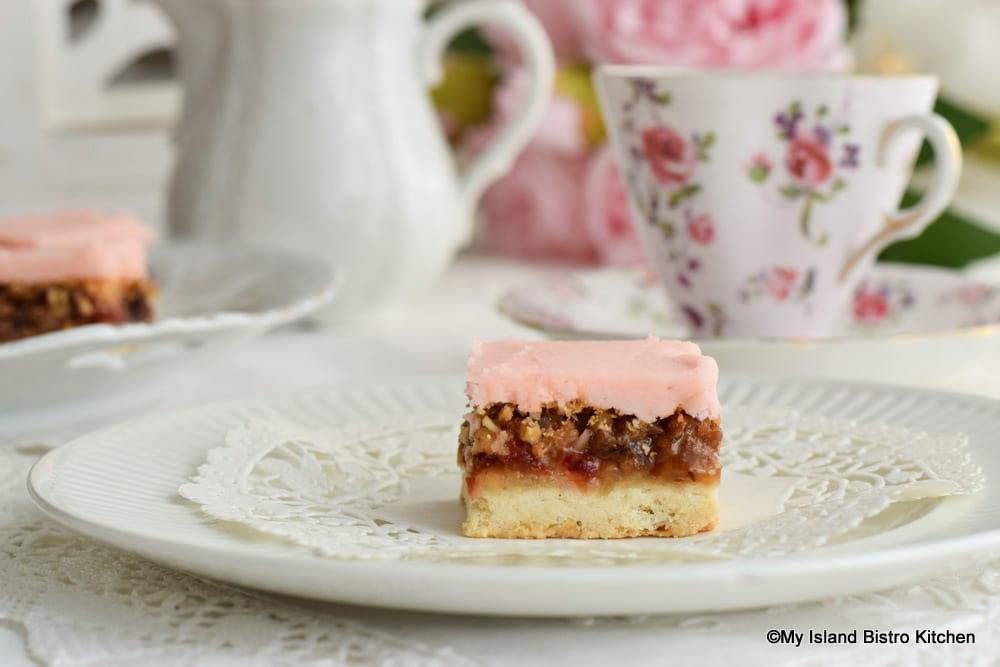
Always a favorite, this three-part square (shortbread base, topping, and icing), known simply as “Dream Square”, is a treat! Sometimes referred to as a vintage or retro square, I’m not sure it has ever been “shelved” long enough in history to put it in that category! This is a square that is, in my view, perennially in vogue. Continue reading Decadent Dream Square Recipe

This lovely Cranberry Shortbread Square with a tender, buttery shortbread crust features cranberry sauce as an ingredient in the topping. The sauce adds lovely flavor and texture making the square rich and delectable. Continue reading Cranberry Shortbread Square Recipe